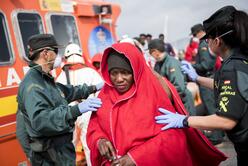The sea and the desert are two of the most unforgiving environments for humans to survive. But thousands of people making the journey along the so-called Central Mediterranean Route – from sub-Saharan Africa, through Niger to Libya and a minority attempting to continue on to Europe – are being left with no choice but to tackle the Earth’s harshest extremities.
People make their way along the route for different reasons – some are fleeing conflict, violence or persecution in their own country, some are escaping extreme poverty and trying to find work. All are hoping for a safer and better life and all will be exposed to the dangers inherent in these harsh physical environments, and to potential exploitation at the hands of people smugglers and security services.

Lost in the desert
Many people hope to find work in Libya, which has long been a destination for people seeking employment from other parts of Africa and around the world. But a crackdown on migration along traditional routes used to reach Libya – demanded by European leaders in response to increased numbers of people arriving on their shores – has pushed people into travelling with smugglers through the dangerous deserts of Niger.
Smugglers pack people into trucks and race across the desert sands whilst people cling on to the sides of vehicles for survival. To avoid the authorities, smugglers take even more risky routes, and people are more likely to be exploited and abused.
If you fall out of the truck – and many do – you’ll be left in the desert, alone, with the red-hot sun beating down 50-degree heat. With no water, food or protection, many people perish.
The exact numbers of people who die are unknown.
Desert detention
For those who make it to Libya, the threat to life remains real. Libyan authorities have criminalised all irregular entry into the country. Thousands of men, women and children are imprisoned as a result, some of them in centres in the desert.
Some are detained in unofficial facilities, controlled by violent armed militia. Sexual abuse, indiscriminate beatings, torture and killings are rife.
Women trapped in these conditions are particularly vulnerable; some are raped and have to remain in detention whilst pregnant.
Making it across the sea alive
Research shows that only one in five people travelling along the Central Mediterranean Route attempt the crossing to Europe.

Many of them are simply trying to escape the horror of Libya – no longer wanting to live in constant fear of abduction, or without access to basic services and the means to live. Smugglers often take all the money people have, with the promise that once they reach Europe they will find the jobs and safety they’re desperately searching for.
Most will never make it very far across the sea, and will be intercepted by the Libyan Coastguard and sent to detention centres. But for those who do, they face the ocean in overcrowded boats that often don’t have enough fuel to make it across to Italy.
So far this year, 1,852 people have lost their lives at sea. This number will doubtless rise.
So far this year, 1,852 people have lost their lives at sea.
Hundreds of women, children and men are being left adrift at sea whilst governments debate where their boat can dock.
Action is desperately needed to change this situation. Our 10-point plan shows what political leaders should do to protect and save lives, and adopt a more values-based and humane approach to migration management.
The International Rescue Committee is working with vulnerable people on the move in Niger, Libya and Italy. We provide emergency health care, cash support, information, and case management for particularly vulnerable people, including children and survivors of gender-based violence (GBV).
Wherever people are along the world’s most dangerous route, the impossible choices they face are laid bare.
People fleeing danger have a legal right to claim asylum but no safe and legal pathway which lets them do so. Their journey to safety need not be so dangerous.
Learn more
Tortured and on the run from militias, meet some of the young people who escaped Libya.
Read the IRC’s new report, “Pushing the Boundaries: Insights into the EU’s response to mixed migration on the Central Mediterranean Route.”